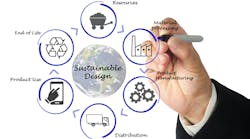Editor's Note: To pick up the conversation where the pages of our February “Science of Design” edition left off, we are pleased to re-introduce psychologist Dr. Nicola Davies, author of “Empathy in Architecture” from our March 2014 issue, who will be sharing her weekly insights on cognitive architecture and evidence based design. In honoring the fields’ analytical methodologies—while aiming for blog-like brevity—many of Davies’ points are kept short and backed up by full academic studies and research reports, which you can access via the hyperlinks further reading. We hope you’ll enjoy taking a deeper dive into some of these issues, but first, let’s start with the basics: what exactly are cognitive architecture and evidence based design anyway? We'll let Dr. Davies answer that...
Every element of a built environment can have a considerable positive or negative impact on our state of mind and emotional well-being, or so we like to think. But how can we prove it? That’s where evidence based design (EBD) comes into play—and fortunately, as research on the psychological and neurological impact of certain design elements is constantly being enhanced, designers are more equipped than ever with objective facts to back up their seemingly subjective choices.
But there are also aspects of EBD not yet explored, allowing designers to experiment with the information available to them, together with their own aesthetic judgments, in order to create a design specifically tailored to the client’s needs. An EBD process includes identification of project scope, research and observation, reporting, and drawing conclusions based on the individual objectives of the customer. Designers need to learn these skills and understand the principles of EBD in order to make the most of the technique and add value to the services they offer their clients.
What is Evidence Based Design?
EBD was at least partially born out of patient-centric evidence-based practice in healthcare and is consequently finding wide acceptance in health care centers. In a hospital, for example, the physical environment can help to heal patients faster. EBD within healthcare can also help caregivers to perform better in their jobs by decreasing stress and dissatisfaction through natural elements, such as indoor plants and running water. This trend has been gaining momentum gradually in the architecture and design industry in a variety of alternative settings including schools, museums, and prisons. The growing focus on green designs and sustainability has also encouraged the use of EBD in architecture and interiors.
The Importance of Cognitive Architecture, and What Evidence Based Design is Not
‘Cognitive architecture’ is an emerging design system based in cognitive neuroscience (studying brain capabilities like motivation, decision-making, emotional response, and memory), which aims to understand brain activation and response patterns and how they can be applied to the built environment. The scientific community is taking exciting leaps in understanding how the human brain works, what triggers it, and what responses those triggers induce. In the process, a wide range of studies of the psychological and neurological impact that the environment has on people now have published results that are easily available to designers. Evidence Based Design (EBD) uses this scientific evidence as a foundation of knowledge on which to base cognitive design decisions and metrics for success.
However, unlike the harsh constraints of psychology and neuroscience (the stuff of control groups, isolated responses, and painstakingly-measured constants) EBD isn’t a confining and stagnant template without any room for creativity; it combines both the results of such research and artistic imagination to elevate moods, improve focus, and enhance efficiency. The average office space or public plaza is far from the vacuum-sealed precision of a test lab. Weather changes, traffic ebbs and flows, people behave in a chaotic mish-mash of instantaneous every day choices, and somewhere, in Bhutan perhaps, a butterfly flaps its wings. The trend towards EBD means that designers will need to become comfortable with research in order to keep up-to-date with the latest developments and best practices within their field, while remaining deftly attuned to the environmental elements whose impacts remain beyond scientific measure.
And with that in mind, stay tuned for next week’s post, which will identify a few key ways your designs may already be eliciting emotional and behavioral responses, whether you intended it to or not.


